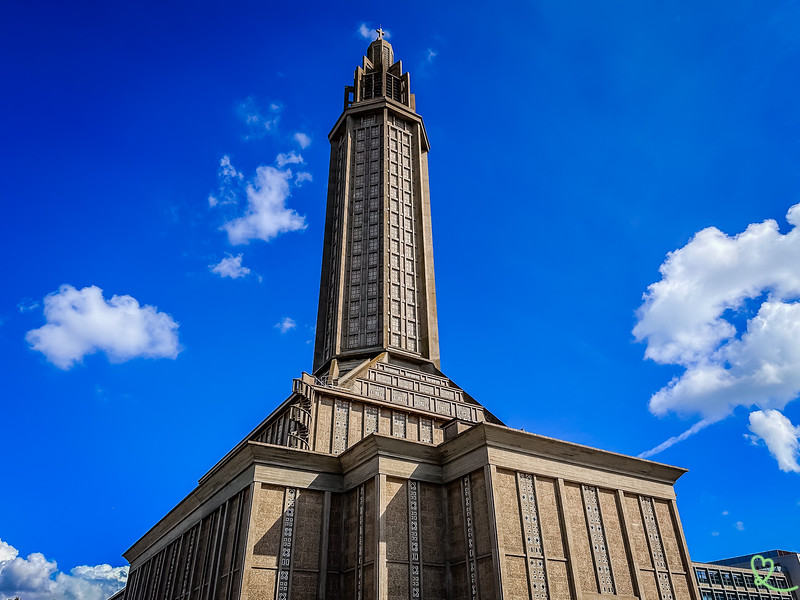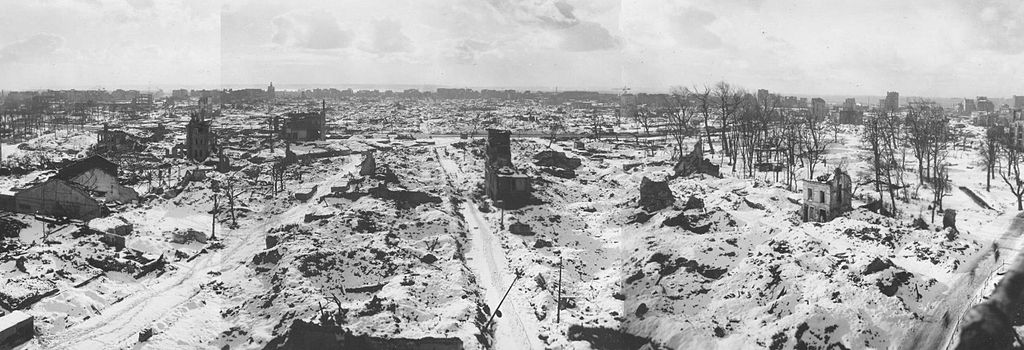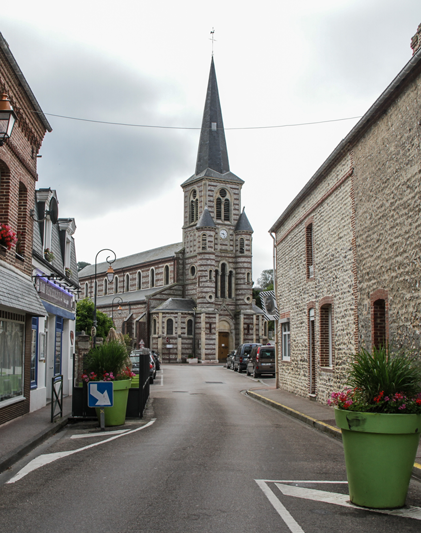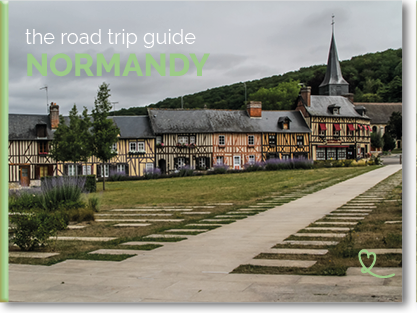During your stay, don’t miss a visit to Le Havre’s amazing Saint-Joseph Church.
This religious building is one of the most audacious architectural achievements of architect Auguste Perret , who rebuilt the city of Le Havre after its destruction at the end of the Second World War.
In this article, we’ll tell you all about theunusual history of this unique building, and guide you in your visit and discovery of the site with the help of numerous photos.

This review is completely independent, we visited anonymously.
Why visit St. Joseph’s Church?
Is Saint Joseph Church worth it? Our opinion:
A visit to St. Joseph’s Church is unquestionably a must on any visit to Le Havre:
- for its contemporary architecture and stylistic use of reinforced concrete
- for the stained glass windows, particularly in the lantern tower, which brings exceptional light into the church
- for the symbolic power of the site: 107 metres high, it is a veritable spiritual and secular beacon in a town that was completely destroyed in September 1944

What’s St. Joseph’s Church famous for?
St. Joseph’s Church owes its renown to the reconstruction of Le Havre and its UNESCO listing in July 2005.
Following the bombings of September 1944, the reconstruction of Le Havre was entrusted to French architect Auguste Perret, marking the high point of his international career. He built a resolutely modern city, exploiting the full potential of his favorite material, reinforced concrete.

In the context of this 10-year project, the construction of the church is particularly symbolic. It is both a place of worship and a memorial to the Second World War, embodying the rebirth of Le Havre.
But beyond this dimension, it is also one of the masterpieces of modernism, revisiting religious architecture, and a technical feat. We’ll tell you all about it!
Is Saint-Joseph Church Le Havre Cathedral?
A source of confusion for many visitors,Église Saint-Joseph is not Le Havre Cathedral.
Le Havre Cathedral is one of the few buildings to have survived the bombardments of 1944, blending the architectural styles of the 16th and 17th centuries.

Fortunately, only 750 meters separate the 2 buildings, and as we wandered around the city, we were regularly able to redirect lost tourists looking for the “Cathédrale Perret” or the “Cathédrale Saint Joseph”.
We’ll tell you more about Le Havre Cathedral at the end of this article.
WHERE TO STAY IN Le Havre
Option 1: seafront
With beautiful views over the horizon, we recommend it:
- Hilton hotel with modern decor and balconies – see prices, photos and availability.

Option 2: downtown
Surrounded by Perret architecture and works of art, we recommend..:
- Hôtel Pasino, for ultra-spacious rooms – see prices, photos and availability
- Hotel Vent d’Ouest, a charming place to stay – see prices, photos and availability

Option 3: next to the station
For convenient access to all forms of transport, and modern hotels, choose the station. We recommend..:
- Aparthotel Odalys with modern, practical apartments – see prices, photos and availability.

History in brief
Initially a simple wooden chapel, blessed in 1871, the first Saint-Joseph church was built between 1873 and 1877 in the neo-Gothic style typical of most French churches.
On June 14, 1944, the first bomb destroyed part of the nave and the main façade. The church was destroyed by another bombing raid on September 5, 1944.
After 5 days of intense bombardment, 82% of the city of Le Havre was destroyed and 18 kilometers of the port’s docks rendered unusable. It would take almost 20 years for the new town of Le Havre to rise from the rubble.

Perret’s 1926 designs for the Basilique Sainte Jeanne d’Arc in Paris were the inspiration for the new Église Saint-Joseph in Le Havre. The foundation stone was laid on October 21, 1951, and the building was inaugurated in 1957.
Auguste Perret, who died in 1954, did not see the completion of his work, which was later entrusted to architect Raymond Audigier.
Subscribe to our Newsletter
- Get away from it all with Region Lovers’ beautiful destinations!
- Once a month
- Advertising-free
Practical tips and map of St Joseph’s Church, France
Where Saint Joseph Church is located
- Driving time from Rouen: 1h10
- Driving time from Evreux: 1h30
- Driving time from Caen: 1h15
- Driving time from Alençon: 2h
- Driving time from Cherbourg: 2h20
How to get there
To get to Le Havre, you can choose between:
- By train: the town is linked to Rouen and Paris via an intercity train, with an average of 16 journeys a day, and you should allow around 2 hours 20 minutes. Plan ahead, as delays (although improving) are still common on this line since our childhood…
- Bus: regular bus services link Le Havre to Paris airports and several provincial cities. It will take between 2 and 3 hours, about the same as by train.
- By car: Le Havre is connected to 2 motorway networks, the A13 to Paris and the A29 to the north of France and Belgium, and the south-west of France.
See available timetables and book your train and coach tickets now.
Once you’ve arrived in Le Havre, a network of buses, streetcars and scooters will get you quickly to St. Joseph’s Church and to the city. Getting around the city is easy, and parking is relatively straightforward.
- Bus: lines 1 and 13 – Saint Joseph stop
- Tramway: terminus – beach stop
OUR ADVICE FOR RENTING A CAR IN Normandy
- Compare prices on our preferred platform: DiscoverCars – one of the best rated sites.
- Choose a car that is comfortable enough (distances can be long) but compact (some parking lots and villages are narrow).
- Think of thecomplete insurance (some roads are tortuous and narrow).
- There is a lot of demand, book it early.

Parking
St. Joseph’s doesn’t have its own parking lot, but you can easily park on the road.
Pay parking is available in the surrounding streets, but just 100m away, along boulevard Clémenceau on the seafront, you’ll find plenty of free parking.
Best time to visit Saint Joseph’s Church
The church is open all day, all year round. However, it is advisable to avoid the mass times (late Saturday and Sunday mornings). Visits should also be avoided when a funeral is in progress.
During the summer season, the church often welcomes groups from cruise ships calling at Le Havre, but that’s no reason to get in the way during your visit.
To take full advantage of the church’s play of light, visit during the day and, if possible, at a time when the sun is shining.

How long does it take to visit the church and what are the main difficulties?
We recommend setting aside around 30 minutes to visit the churches. The interior is relatively austere, but the light is so special that it’s worth taking the time to observe the sun’s reverberations and soak up the atmosphere.
Advice on how to visit
There’s no real sense of direction. Before entering the building, take a moment to observe its distinctive architecture, with its imposing base supporting the monumental lantern tower at 107 meters.
Once inside, you’ll be amazed by this vast 50,000m3 volume, with no central support, and by the austerity of the place (due to the use of reinforced concrete), enhanced by the non-figurative stained glass windows, playing on colors alone.
USE OUR GUIDE TO PLAN A
DREAM TRIP TO Normandy
All the information you need for your trip:
- 8 maps that make planning easier
- 160+ pre-selected locations
- Practical advice
- 300+ photos to help you choose

Schedules and prices
The church is open daily from 10am to 6pm, except for ceremonies. The access and the visit are free.
Guided tours
Guided tours are offered during the summer months, and you’ll need to contact the Tourist Office for further details.
The remarkable architecture of Saint-Joseph Church
The stained glass windows
Like the rest of the building, the church’s stained glass windows are a bold choice. Instead of traditional figurative stained-glass windows, often depicting biblical figures or scenes, we opted for a magnificent geometric combination of 12,768 colored glasses.

Mouth-blown, they are therefore irregular, both in thickness and in shade. They come in no fewer than 7 colors (orange, yellow, green, violet, red, greenish and white), with a layout that concentrates most of the light in the lantern tower, symbolizingspiritual elevation.
Although non-figurative, these tiles are no less meaningful for their shape:
- the triangle: the Holy Trinity
- the square: the Earth
- the vertical rectangle: man’s aspiration to the Spiritual
or color:
- red (predominantly on western slopes): blood of the martyrs.
- neutral lilacs (predominant on northern slopes): darkness, death.
- pink, gold and green lilacs (mostly on eastern slopes): the Nativity.
- loir and orange (predominant on the southern slopes): Splendor, glory of God.

We owe this phenomenal work to Margareth Huré, a French master glassmaker who collaborated with Auguste Perret on several occasions. A rare woman in this highly masculine profession, she never ceased to surprise and intrigue her era.
The structure
Far from the traditional plans of French churches, the church is structured around the lantern-tower, a pyramidal structure resting on 16 pillars that sink 12 meters below the church floor.

Take time to observe this complex assembly, with each group of 4 pillars joined by a concrete X (also known as a Saint Andrew’s cross, if you want to shine at your next dinner party) to further reinforce its solidity.
OUR ADVICE FOR RENTING A CAR IN Normandy
- Compare prices on our preferred platform: DiscoverCars – one of the best rated sites.
- Choose a car that is comfortable enough (distances can be long) but compact (some parking lots and villages are narrow).
- Think of thecomplete insurance (some roads are tortuous and narrow).
- There is a lot of demand, book it early.

Concrete
A far cry from the cut stone usually used for the most emblematic religious buildings, St. Joseph’s Church, like the rest of the town center, was built in reinforced concrete (sand, gravel, cement, reinforced with steel rods).
Invented in the second half of the 19th century, the use of concrete developed gradually during the first half of the 20th century. Auguste Perret made it his material of choice for both its constructive and economic qualities. In the midst of the Brutalist movement, he didn’t hesitate to expose it, assuming his choice of robust, unadorned architecture, but not without nuances of color and treatment.

Not necessarily attractive at first glance, it becomes truly surprising when you learn to look at it and see how it interacts with the colors of the sky. And having lived in “Perret” for many years, we can assure you of its resistance to both weather and sea spray.
The furniture
Here, too, modernity is the order of the day, with a granite altar positioned in the center of the church, and surrounded in an arc by 800 cinema-style seats. Truly surprising, and with relative comfort, as we experienced at the last Christmas mass.

Nor can you miss the metal canopy that has protected officiants from the draughts generated by the lantern tower since 1980. An unfortunate oversight in an otherwise draughty city.
Subscribe to our Newsletter
- Get away from it all with Region Lovers’ beautiful destinations!
- Once a month
- Advertising-free
Other religious buildings in Le Havre
Notre-Dame du Havre Cathedral
Often confused with Saint-Joseph church, Notre-Dame du Havre cathedral is less than 800 m from rue de Paris. Compared with other French cathedrals, this modest edifice blends the architectural styles of the 16th and 17th centuries (from late flamboyant Gothic to early Classicism).

Although battered by the city’s various conflicts over the centuries, it is one of the few buildings that Auguste Perret didn’t completely raze to the ground during Le Havre’s post-war reconstruction.
Perhaps this is why it was elevated to Cathedral status in 1974 by Pope Paul VI.
Graville Abbey
Unfairly overlooked, even by the people of Le Havre, Graville Abbey boasts a magnificent Romanesque abbey church whose construction began in the late 11th century. In the nave, look up to see the richly decorated column capitals.

The church is dedicated to Sainte Honorine, who, according to legend, was killed by pagans in Lillebonne (35 km east of Le Havre), thrown into the Seine and washed up at the foot of the abbey.
The cliffside site also features a romantic cemetery and a collection of medieval statuary.
The whole thing is spellbinding, and we really enjoyed the belated discovery of this treasure of our city.
Notre-Dame des flots chapel
Located in the hills above Sainte-Adresse, this adorable little Gothic-style chapel was built in 1859. It is dedicated to the Virgin Mary, protector of sailors and fishermen.

Witness to this devotion, and anchoring the building in the town’s daily life, numerous plaques, thank-yous, paintings and models implore the Virgin to entrust Le Havre’s sailors to her care.
Maybe it’s because our grandparents lived almost opposite, but we have a special affection for this little building and its adjoining poets’ garden .
PLAN YOUR STAY IN Le Havre
- Best things to do in Le Havre
- The beach of Le Havre
- Where to stay in Le Havre
- Where to eat in Le Havre – coming soon
- Weekend in Le Havre

Frequently asked questions
Who is Saint Joseph?
St. Joseph is a carpenter by trade, and the patron saint of the Catholic Church, protector of workers, especially carpenters and joiners. This protection makes sense for a building that symbolizes the reconstruction of Le Havre.
St Joseph’s Church or the Empire State Building?
The reconstruction of Le Havre on a quadrilateral plan, with its lantern tower reminiscent of New York’s Empire State Building, has led some to wonder whether Auguste Perret was influenced by American architecture.
We’ll let you make up your own mind!



